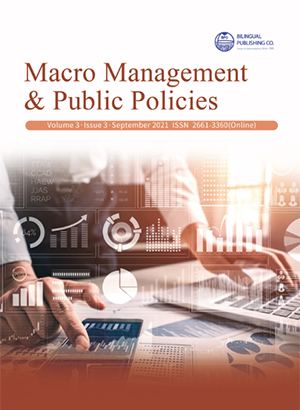-
919
-
353
-
277
-
260
-
260
Sustainability in Higher Education Institutions (HEI): Merging the Study Systematic Review, Analysis Content and Bibliometrics
DOI:
https://doi.org/10.30564/mmpp.v3i3.3670Abstract
This study aims to explore how the topic of sustainability in Higher Education Institutions (HEI) has been addressed in the scientific literature. It presents a systematic literature review of peer-reviewed journal articles published between 1975 and 2019. After that, bibliometric and content analyses were performed in order to identify the behavior and evolution of the literature and identify the frequency with which they appear in the text, making it possible to raise replicable and valid inferences to the data. The results of this study indicate that the theme is emerging since the year 2010 and with a strong focus on qualitative studies, focused on critical theory. The results indicate that although studies involve the tripod environment, economy, and society, there is still a gap in studies that deal with specific issues to solve practical problems and that analyze the impacts from a more holistic perspective. The combination of methods made it possible to identify and interpret the articles in the selected sample, but based on results reported by other authors, with little room for quality control and integrity.
Keywords:
Sustainability; Systematic and bibliometrics review; Content analysis; Higher education institutions (HEI)References
[1] Sachs, I, 1986. Ecodevelopment: grow without destroying. Vértice, São Paulo.
[2] Sachs, I, 1993. Transition strategies for the 21st century: development and environment. Studio Nobel/ Fundap, São Paulo.
[3] Maimon, D, 1992. Company and Environment. Time and Presence. Tempo e Presença, 14, 261, 49-51.
[4] Maimon, D, 1994. Eco-strategy in Brazilian companies: reality or discourse? Journal of Business Administration, 34, 4, 119-130. https://doi.org/10.1590/S0034-75901994000400013
[5] Maimon, D, 1996. Green Passport: environmental management and competitiveness. Qualitymark, Rio de Janeiro.
[6] Donaire, D, 1994. Considerations on the influence of the environmental variable on the firm. Journal of Business Administration, 34, 2, 68-77. DOI: https://doi.org/10.1590/S0034-75901994000200008
[7] Barbieri, JC, 2001. Development and Environment: Agenda 21’s Strategies for Change. Vozes, Petrópolis.
[8] Berté, R, 2009. Social and Environmental Management in Brazil. Saraiva, São Paulo.
[9] Arvidsson, K, 2004. Environmental management at Swedish universities. International Journal of Sustainability in Higher Education, Hamburg, 5, 1, 91- 99. DOI: https://doi.org/10.1108/14676370410512616
[10] Noeke, J, 2000. Environmental management systems for universities: A case study. International Journal of Sustainability in Higher Education, 1, 3, 237-251. DOI: https://doi.org/10.1108/14676370010378167
[11] Herremans, I; Allwright, DE, 2000. Environmental management systems at North American universities: What drives good performance? International Journal of Sustainability in Higher Education. Hamburg, 1, 2, 168-181. DOI: https://doi.org/10.1108/1467630010371902
[12] Carpenter, D; Meehan, B, 2002. Mainstreaming environmental management: case studies from Australasian universities. International Journal of Sustainability in Higher Education, 3, 1, 19-37. DOI: https://doi.org/10.1108/14676370210414155
[13] Sammalisto, K Arvidsson, K, 2005. Environmental management in Swedish higher education Directives, driving forces, hindrances, environmental aspects and environmental co-ordinators in Swedish universities. International Journal of Sustainability in Higher Education, 6, 1, 18-35. DOI: https://doi.org/10.1108/14676370510573113
[14] Ashby, A, Leat, M, Hudson-Smith, M, 2012. Making connections: a review of supply chain management and sustainability literature. Supply Chain Management: an international journal, 17, 5, 497-516. DOI: https://doi.org/10.1108/13598541211258573
[15] Bufrem, L; Prates, Y, 2005. Registered scientific knowledge and information measurement practices. Information Science, Brasília, 34, 2, 9-25. DOI: https://doi.org/10.1590/S0100-19652005000200002
[16] Hart, SL, 1997. Beyond greening: Strategies for a sustainable world. Harvard Business Review, 75, 1, 66, 1997.
[17] Uhl, C., D. Kulakowski, J. Gerwing, M. Brown and M. Cochrane. 1996. Sustainability: A touchstone concept for university operations, education, and research. Conservation Biology 10(1308): 1311.
[18] Lozano, R, 2006. Incorporation and institutionalization of SD into universities: breaking through barriers to change. Journal of Cleaner Production, 14, 9-11, 787-796. DOI: https://doi.org/10.1016/j.jclepro.2005.12.010
[19] Alshuwaikhat, HM, Abubakar, I, 2008. An integrated approach to achieving campus sustainability: assessment of the current campus environmental management practices. Journal of Cleaner Production, 16, 6, 1777-1785. DOI: https://doi.org/10.1016/j.jclepro.2007.12.002
[20] Daub, CH, 2007. Assessing the quality of sustainability reporting: an alternative methodological approach. Journal of Cleaner Production, 15, 1, 75-85. DOI: https://doi.org/10.1016/j.jclepro.2005.08.013
[21] Lozano, R; Lukman, R; Lozano, FJ; Huisingh, D; Lambrechts, W, 2013. Declarations for sustainability in higher education: becoming better leaders, through addressing the university system. Journal of Cleaner Production, 48, 1, 10-19. DOI: https://doi.org/10.1016/j.jclepro.2011.10.006
[22] Lozano, R, 2010. Diffusion of sustainable development in universities’ curricula: an empirical example from Cardiff University. Journal of Cleaner Production, 18, 7, 637-644. DOI: https://doi.org/10.1016/j.jclepro.2009.07.005
Downloads
How to Cite
Issue
Article Type
License
Copyright © 2021 Author(s)

This is an open access article under the Creative Commons Attribution-NonCommercial 4.0 International (CC BY-NC 4.0) License.




 Érika Pena Bedin
Érika Pena Bedin

